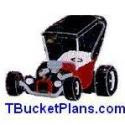To start, here's the definition from no less an authority than the "Ultimate Hot Rod Dictionary: A-Bombs to Zoomies" by Jeff Breitenstein:
fad-T (also fad car) n. Any T-bucket roadster constructed entirely from new, prefabricated components, including a reproduction fiberglass body. The first aftermarket fiberglass roadster bodies featured in hot rodding and street rodding applications were introduced (notably by Cal Automotive) in the late 1950s. From the early to mid-1960s, T-bucket roadster kits gained in sophistication and completeness; the resulting fad-T trend peaked in popularity in the late 1960s and has maintained moderate favor to the present. Fad-Ts offer the advantages of simpler construction and lower initial cost when compared with other street rod types, but are sometimes discounted by rodders who prefer genuine vintage tin bodies and components.
I'll put a stake in the ground and say that the term fad-T was first used in print by the legendary hot rod writer and builder LeRoi "Tex" Smith in the July 1964 edition of Rod & Custom magazine. Fresh from building the innovative XR6, which was crowned America's Most Beautiful Roadster at the 1963 Oakland Roadster Show, perhaps no other person at the time was better qualified to write a story on "Trends in Roadster Styling". In comparing "traditional" roadsters and modern roadsters, Tex noted that:
"(The modern) category also takes into account the 'fad' cars, as they have come to be known. These are the 'kookie' cars that have become the rage in various sections of the country. In the early days of hot rodding they were called modifieds. They consist of an engine, frame, four wheels and a body. And not much else. They are generally of the bobtailed version, using a '23 glass Model T body set at a rakish angle on channel iron frame rails. The engine is very much out of doors, with outside drag headers modified (usually plugged) to feed the exhaust through stock mufflers under the body. Stock height windshields and tops add to the strange illusion of great height of these styles.
Although the kookie cars are never identical in every respect, they do look the same. Thus the tab of 'fad' cars by the more traditional builders.
These cars are really quite easy to build, especially since they have become so popular. There are several major speed companies now offering complete kits for building such a car, which makes them even more reasonable. They also make ideal show machines, as they catch the fancy of the general public. However, unlike the other categories, they are not the greatest for highway cruising. Much fun around town, though. Many West Coast builders are now even chauffering two cars, a kookie machine and one of the other approaches."
(Tex really knew what he was talking about. In later describing how the XR6 was conceived, he said, "I had been using a lot of drawings from artist Steve Swaja, a student at the time at the nearby Art Center. One day I asked if he could design a roadster project for me, using a combination '23/'27 Model T body and a race car nose. This was the drawing that we used as the project was introduced in Hot Rod. Curt Hamilton and Bud Lang had recently begun producing the first fiberglass replicas of the Model T bodies, mostly for drag cars. Their company was called Cal Automotive. Curt made me up a '27 cowl mated to an upswept '23 rear portion." However, this design concept swiftly changed when Tex received a phone call that a major model car company was willing to pay for the whole project if it was really far out. The rest is hot rod history.)
Tuesday, June 2, 2009
Subscribe to:
Posts (Atom)




